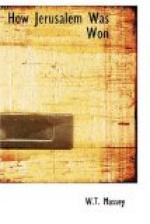The fighting of the Yeomanry Mounted Division on the left of the 52nd was part and parcel of the XXIst Corps’ effort to get to the Nablus road. It was epic fighting, and I have not described it when narrating the infantry’s daily work because it is best told in a connected story. If the foot sloggers had a bad time, the conditions were infinitely worse for mounted troops. The ground was as steep, but the hillsides were rougher, the wadis narrower, the patches of open flat fewer than in the districts where infantry operated. So bad indeed was the country that horses were an encumbrance, and most of them were returned to the plain. After a time horse artillery could proceed no farther, and the only guns the yeomanry had with them were those of a section of the Hong Kong and Singapore mountain battery, manned by Sikhs, superb fellows whose service in the Egyptian deserts and in Palestine was worthy of a martial race. But their little guns were outranged by the Turkish artillery, and though they were often right up with the mounted men they could not get near the enemy batteries. The supply of the division in the nooks and crannies where there was not so much as a goat-path was a desperate problem, and could not have been solved without the aid of many hundreds of pack-donkeys which dumped their loads of supplies and ammunition on the hillsides, leaving it to be carried forward by hand. The division were fighting almost continually for a fortnight. They got farther forward than the infantry and met the full force of an opposition which, if not stronger than that about Nebi Samwil, was extremely violent, and they came back to a line which could be supplied with less difficulty when it was apparent that the Turks were not going to accept the opportunity General Allenby gave them to withdraw their army from Jerusalem. The Division’s most bitter struggle was about the Beth-horons, on the very scene where Joshua, on a lengthened day, threw the Canaanites off the Shephelah.




